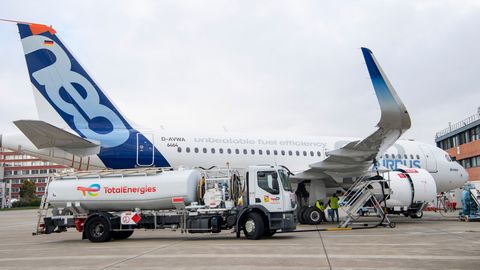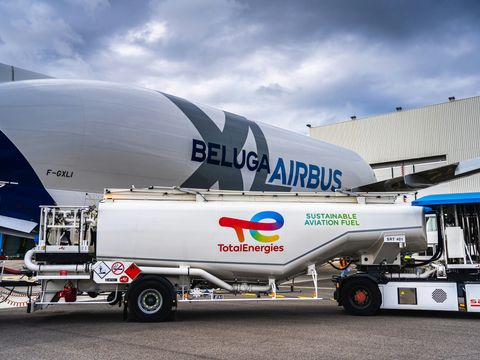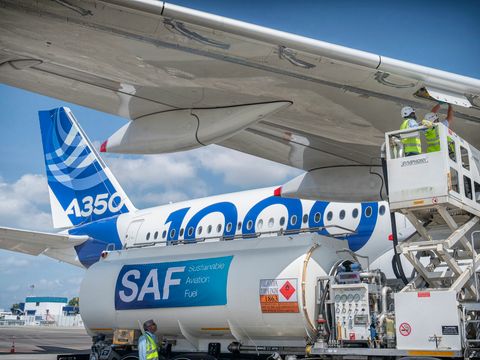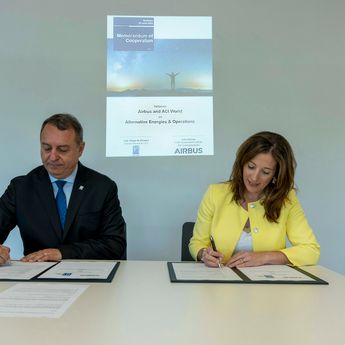When it comes to decarbonising the aviation industry, there’s no single solution that can magically cut emissions. Instead, it’s a layered task: multiple levers need to be put to work together, each one reducing and addressing emissions in its own way. Airbus is putting this idea into practice, combining four levers in a single flight.
Between 17-21 November 2025, Dubai Airshow will open its doors to the public. With the tagline ‘The Future is Here’, this 19th edition of the show has a focus on technological advancements, innovative products and technologies. Where better for Airbus to bring together four key complementary levers in a single flight – latest generation aircraft, sustainable aviation fuel (SAF), Book and Claim (B&C) and carbon dioxide removals (CDR) – to showcase how each of these levers can play a part in reducing the emissions gap.
Today, around 30% of the world’s in-service aircraft fleet are of the latest generation, which deliver a 20-30% fuel saving compared to their predecessors. Replacing older aircraft with more modern ones – like the Airbus A350-1000, which first entered into service in 2018, and requires on average 25% less fuel than previous generation aircraft – is a key way for the aviation industry to make progress towards decarbonisation.
In fact, it is an Airbus A350-1000, flying from Toulouse to Dubai, which will provide an opportunity to showcase the various decarbonisation levers in a single flight. While the use of all these levers in routine operations is still rare and challenging for airlines to implement, this showcase aims to emphasise the point that no single technology in isolation can help the aviation industry reach its decarbonisation targets.
Multiple levers, working in parallel
Industry bodies like ATAG recognise the complexity of decarbonising aviation in their Waypoint 2050 report (2nd edition, 2021). In their three scenarios which depart from a continuation of current trends, SAF remains the lever with the capacity to make the greatest difference, accounting for between 53-71% of emissions reduction contributions in 2050. This depends on the level of ambition and commitment with which the industry embraces decarbonisation and the particular levers that gain the most focus and support.
Alongside SAF, market-based measures such as carbon dioxide removals will be needed to close the emissions gap by 2050. This combination of SAF and carbon removals or other emission mitigation options presents the industry with a practical solution to many of the challenges that put pressure on the wider adoption of SAF.
Inspired by these scenarios, Airbus is deploying the following levers to address each tranche of emissions created during the flight:
Deconstructing our SAF, B&C and CDR showcase flight
Sustainable aviation fuel (SAF)
The A350 is travelling from Airbus’ operational headquarters in Toulouse, France, to Dubai, United Arab Emirates, to participate in the Dubai Airshow flying display. For this flight the A350 will benefit from a 35% blend of physical SAF. The remaining 65% will be conventional aviation fuel (CAF).
Toulouse is well-served to supply SAF, as it benefits from not only the infrastructure at Toulouse-Blagnac Airport but also Airbus’ own dedicated fuelling facilities, but this is not the case for all cities. So what options are there when SAF is not readily available or where an airline or operator may wish to have a greater percentage of SAF than is physically available on site?
Book and Claim (B&C)
An airport or airline may be enthusiastic about using SAF, and willing to pay the additional cost to acquire it – SAF costs between 2-7x conventional aviation fuel, depending on the feedstock – but there may be logistical challenges that make it complex to have SAF delivered where they operate, for example, being located in a part of the world without easy access to SAF producers or suppliers.
For this reason, there exists an accounting mechanism called ‘Book and Claim’ that enables airlines and airports to be able to take advantage of SAF without needing to physically take delivery of it. We can use this to virtually replace the CAF on the flight. By using Book and Claim, Airbus purchases SAF emissions reduction certificates from an independent registry, the Roundtable on Sustainable Biomaterials (RSB), an NGO that defines sustainability standards for SAF.
In simple terms, the Book and Claim mechanism allows a buyer to “book” a certain amount of SAF and “claim” the corresponding emission reduction, even if the fuel is used elsewhere. Book and Claim could be a key lever in the scaling of SAF, connecting supply and demand and improving SAF accessibility for potential customers, particularly those located far from supply points or production facilities. In practice, this means the physical SAF is delivered to another operator, which then consumes the amount of SAF as indicated by the certificate.

Carbon dioxide removals (CDR)
Even by effectively replacing all of the fuel with SAF (through a mixture of physical SAF and through SAF Book and Claim certificates), emissions remain. Airbus will use carbon dioxide removal (CDR) units to neutralise the residual emissions of this flight. CDR is a credible measure for addressing residual remaining emissions by physically removing carbon dioxide from the atmosphere and storing it. For this specific flight, Airbus has selected CDRs from reforestation projects in Mexico which are certified by the Climate Action Reserve (vintage 2022-2023).
What does this showcase reveal about aviation’s path to decarbonisation?
The whole industry needs to come together to tackle decarbonisation, from airlines to airports, and fuel producers to OEMs like Airbus, as well as regulatory bodies. We are playing our part: increasing the use of SAF in our own operations with fuel providers like TotalEnergies, participating in the SAFFA Fund alongside AirFrance-KLM Group and Qantas, amongst others, and investing directly in SAF producers like LanzaJet.
When it comes to Book and Claim, Airbus has launched its own Demonstrator in collaboration with RSB. The demonstrator has the ambition to facilitate demand from some of its smaller-scale customers and connect it with supply, making it easier for these clients to access SAF. Airbus has also been working to raise the profile and credibility of Book and Claim as a mechanism. As yet, Book and Claim is not recognised by the regulated markets – neither by the EU Renewable Energy Directive nor by CORSIA – however Airbus believes this could be a powerful lever to make SAF more accessible and is advocating for the recognition of this lever.
The aviation industry will not reach its long-term aspirational goal of net-zero carbon emissions overnight. To achieve this by 2050 will take hard work, investment, regulatory support, and the willingness of all industry participants to drive progress. The industry agrees that multiple levers are the way to go. This flight takes that idea, and puts it in the air.
Download
Document

Report on the Dubai Airshow A350 Flight - Substantiation of Environmental Claims
Infographic

SAF-book-and-claim
- Document
- Infographic

Report on the Dubai Airshow A350 Flight - Substantiation of Environmental Claims











